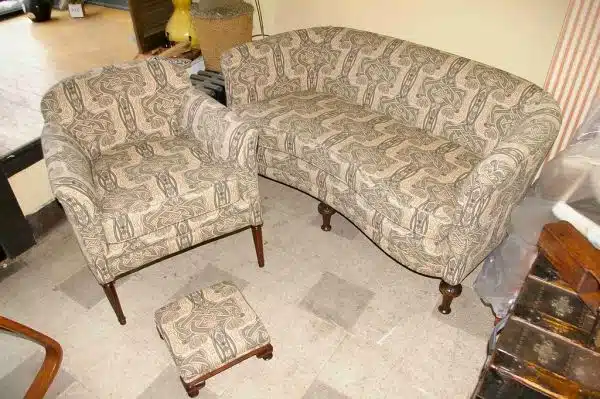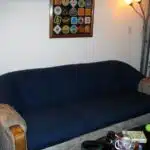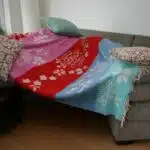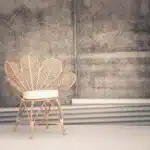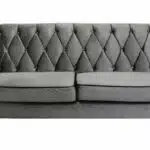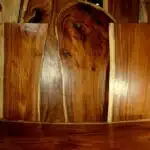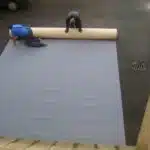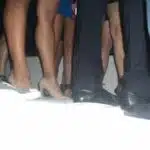Outdoor furniture and upholstery can provide an inviting and comfortable space for relaxing and entertaining outside of the home. However, proper maintenance is required to keep outdoor cushions and fabric furniture in top condition. Cleaning outdoor cushions and fabric furniture may seem like a daunting task, but with the right tools and techniques, it can be accomplished easily.
As an expert in outdoor furniture and upholstery cleaning, I have seen firsthand the damage that neglecting to clean these items can cause. From mold and mildew growth to fading colors, outdoor cushions and fabric furniture can quickly become unsightly if not cared for properly. In this article, I will share my knowledge on how to clean outdoor cushions and fabric furniture effectively, so you can enjoy your outdoor space without worrying about the state of your furnishings.
Why Regular Cleaning Is Important For Outdoor Furniture
Maintaining outdoor furniture is essential to keep it looking great and lasting longer. Regular maintenance helps to prevent damage from environmental factors such as moisture, sunlight, and dirt. Proper cleaning helps to remove any accumulated grime, which can lead to discoloration or even mold growth on your cushions and fabric furniture.
The importance of maintenance cannot be overstated when it comes to outdoor furniture. By regularly cleaning your cushions and fabric furniture, you can help extend their lifespan and save money in the long run. Furniture that is left uncleaned for extended periods will eventually start to break down, fade, or become stained. This can make it harder to clean and may even require replacement.
One of the most significant benefits of maintaining your outdoor furniture is its longevity. By taking good care of your cushions and fabric furniture, they will last much longer than if they were neglected. This means less waste in landfills, fewer materials used for replacements, and ultimately a more sustainable lifestyle. Not only does regular cleaning help you save money by avoiding replacement costs, but it also keeps your outdoor space looking tidy and inviting for years to come.
To get started with cleaning your outdoor cushions and fabric furniture properly, you’ll need to prepare your work area and gather supplies.
Preparing Your Work Area And Gathering Supplies
Regular cleaning of outdoor furniture is important to keep it looking its best and to prolong its lifespan. Outdoor cushions and fabric furniture can become stained, dirty and develop unpleasant odors due to exposure to the elements, food spills, and pets. Therefore, it’s essential to clean them regularly with the right products.
Choosing the right cleaning products is crucial for effective cleaning of outdoor cushions and fabric furniture. While there are many commercial cleaners available in the market, you must select the ones that are safe for your specific type of upholstery. Look for cleaners that are designed specifically for outdoor fabrics and check their ingredients list to ensure they won’t cause any damage or discoloration.
Protecting your skin while cleaning is also essential as some cleaning products can be harsh on your skin. Wear gloves made from a durable material such as rubber or latex when handling chemicals. Additionally, protect yourself from inhaling fumes by wearing a mask or working in a well-ventilated area. Taking these precautions will not only help you clean better but also keep you safe.
Now that you have gathered all supplies necessary for cleaning outdoor cushions and fabric furniture let’s move onto preparing the work area by removing loose debris and dirt before starting the actual cleaning process. By doing this, you’ll avoid pushing dirt deeper into the fibers of your upholstery during cleaning.
Removing Loose Debris And Dirt
One of the joys of outdoor living is being able to relax on comfortable cushions that complement your furniture. However, after regular use, these cushions tend to accumulate dust and dirt. To make things worse, they are exposed to the elements which means that debris and dirt can easily get trapped in the fibers of the fabric. If not removed promptly, these particles can cause discoloration and damage to your cushions. Therefore, it is essential to regularly remove loose debris and dirt from your outdoor cushions.
Ironically, one of the most effective ways to remove loose debris from your cushions is by using a vacuum cleaner! I say ironically because many people assume that vacuum cleaners are only limited to indoor cleaning. However, with the right attachments, you can quickly clear any accumulated dust and dirt from your outdoor upholstery. Start by attaching an upholstery brush or crevice tool to your vacuum cleaner hose. Then gently run it over the surface of your cushion or sofa, focusing on areas where dust usually collects.
Another way to remove loose debris is by shaking out any dirt or dust particles from deep within the fibers of the fabric. This method is especially useful if you don’t have access to a vacuum cleaner or if you dislike using one outdoors. Simply take each cushion and give it a good shake until all visible debris falls off. You may need to do this several times for best results.
Now that you’ve removed all visible debris from your outdoor cushions let’s move onto treating stains and spills caused by food, drink or other substances. Remember that prompt attention helps prevent spills from becoming permanent stains on your furniture!
Treating Stains And Spills
Removing stains on outdoor cushions and fabric furniture can be achieved by using a combination of rubbing alcohol and a gentle detergent. Cleaning spills on outdoor cushions and fabric furniture require a mild detergent, a soft brush, and warm water. To protect outdoor cushions and fabric furniture from future spills and stains, a protective spray can be used to create a barrier on the fabric. Additionally, covering outdoor cushions and fabric furniture when not in use can also help to prevent future stains and spills. To ensure effectiveness, it is important to always check the care tags for specific cleaning instructions for the fabric furniture. Regularly cleaning outdoor cushions and fabric furniture with a mild detergent and warm water can also help to maintain the fabric’s appearance and reduce the need for deep cleaning.
Removing Stains
Removing tough stains from outdoor cushions and fabric furniture can be a challenging task, but with the right approach, it is possible to restore them to their original condition. The first step in treating stains is to identify the type of stain and the material the cushion or furniture is made of. This will help determine the appropriate cleaning solution and method. For example, oil-based stains require a different approach than water-based stains.
Preventing future stains on outdoor cushions and fabric furniture is equally important as treating existing ones. One effective way to prevent future stains is by using protective covers when not in use. This will shield the cushions and furniture from dust, dirt, and other outdoor elements that can cause staining. Additionally, it is important to clean spills and stains as soon as they occur to avoid them setting into the fabric.
When treating stains on outdoor cushions and fabric furniture, it is essential to avoid using harsh chemicals or abrasive materials that can damage the fabric. Instead, opt for gentle cleaning solutions such as mild soap and warm water or vinegar and baking soda solutions for more stubborn stains. Always test a small inconspicuous area before applying any cleaning solution to ensure it does not cause discoloration or damage. With proper care and maintenance, outdoor cushions and fabric furniture can stay looking like new for many years to come.
Cleaning Spills
When it comes to outdoor furniture and upholstery, spills are an inevitable occurrence. Whether it’s a glass of wine or a plate of food, spills can happen at any time, which is why preventing them is crucial. One way to prevent spills is by using waterproof covers when not in use. This will not only protect your furniture from the elements but also prevent stains from setting into the fabric.
If a spill does occur, it’s essential to act quickly to avoid it setting into the fabric. The first step is to blot up as much of the spill as possible using a clean cloth or paper towel. Avoid rubbing the stain as this can cause it to spread and become more difficult to remove.
Removing stubborn stains from outdoor furniture and upholstery requires a gentle touch and patience. Start by mixing a small amount of mild soap with warm water and apply it to the stain using a soft-bristled brush. Gently scrub the area in circular motions until the stain begins to lift. For more stubborn stains, create a paste using baking soda and vinegar and apply it directly to the affected area. Allow the paste to sit for 15-20 minutes before rinsing with warm water. With these techniques, you can effectively treat spills and stains on your outdoor furniture without causing damage or discoloration.
Protecting Furniture
After discussing ways to treat spills and stains on outdoor furniture and upholstery, it is equally important to discuss how to protect the furniture from potential damage. One effective way of protecting outdoor furniture is by using outdoor furniture covers. These covers act as a barrier against the elements such as rain, snow, and sunlight. When choosing protective materials, ensure that they are waterproof and sturdy enough to withstand harsh weather conditions.
Apart from outdoor furniture covers, there are other ways of protecting your outdoor furniture. Choosing the right materials for your furniture can make a big difference in its durability and longevity. Opt for materials that are resistant to water, mold, mildew, and fading caused by UV rays. Additionally, consider placing your furniture in a shaded area or under an umbrella to reduce exposure to direct sunlight.
Lastly, maintaining your outdoor furniture regularly can also help in protecting it from damage. Clean any spills or stains immediately after they occur using gentle cleaning agents. Avoid using harsh chemicals or abrasive tools that could cause damage or discoloration to the fabric. By investing in protective measures such as covers, choosing durable materials, and regular maintenance, you can prolong the life of your outdoor furniture while keeping it looking great for years to come.
Tackling Mold And Mildew Growth
Mold and mildew growth is a common problem that outdoor cushions and fabric furniture owners face, especially in humid areas. These fungi thrive in moisture-rich environments, causing discoloration, unpleasant odors, and potential health hazards. Fortunately, there are several preventative measures that can be implemented to avoid mold and mildew growth. For instance, it is crucial to keep the cushions and furniture dry by wiping off any water or spills immediately. Additionally, storing the items in an area with adequate ventilation can help prevent moisture accumulation.
If you notice mold or mildew on your outdoor cushions or fabric furniture, it is essential to take immediate action to prevent further growth. Natural cleaning solutions such as vinegar or hydrogen peroxide mixed with water can be used to remove mold and mildew stains effectively. However, it is important to test the solution on a small inconspicuous area before applying it to the entire cushion or furniture piece. Once you have applied the solution, let it sit for about 15 minutes before rinsing with water.
To avoid future mold and mildew growth, it is recommended that you clean your outdoor cushions and fabric furniture regularly using natural cleaning solutions. This will not only keep them looking new but also protect your family from potential health risks associated with fungi growth. It is also advisable to store the items properly during extended periods of non-use by covering them with protective covers or placing them in storage containers in a dry location.
In addition to mold and mildew growth, prolonged exposure to sunlight can cause fading colors and damage outdoor cushions and fabric furniture. In the following section, we will discuss strategies for dealing with sun damage and fading colors on your outdoor items.
Dealing With Sun Damage And Fading Colors
Sun damage can cause outdoor cushions and fabric furniture to fade over time. This is due to the UV rays from the sun breaking down the fibers in the material. To prevent fading, it is recommended to keep your outdoor furniture covered when not in use, especially during peak sunlight hours. You can also invest in UV-resistant fabrics or add a protective coating to your furniture.
If your outdoor cushions or fabric furniture has already started to fade, there are DIY remedies that you can try before resorting to professional help. One popular remedy is using a mixture of equal parts vinegar and water to gently clean the surface of the cushion or piece of furniture. Another option is using a fabric dye specifically made for outdoor fabrics to restore color.
Regular maintenance and prevention are key in keeping your outdoor cushions and fabric furniture looking their best. Tips for prevention include regularly cleaning your cushions and furniture, keeping them covered when not in use, and avoiding placing them in direct sunlight for extended periods of time. By following these tips, you can prolong the life of your outdoor furniture and save money on professional cleaning services.
Next up, we will discuss how to wash cushion covers and fabric furniture properly without causing any damage or fading. It’s important to know how to properly clean your outdoor cushions and fabric furniture so that they stay looking fresh year after year.
Washing Cushion Covers And Fabric Furniture
As the sun sets on another summer season, it’s time to assess the damage from those long, hot days. Faded colors and worn-out cushions can leave your outdoor furniture looking less than inviting. But fear not! With a little bit of elbow grease and some insider knowledge, you can have your outdoor space looking as good as new in no time.
When it comes to washing cushion covers and fabric furniture, choosing the right detergent is key. Look for a product that is specifically designed for outdoor fabrics, as these will be formulated to tackle dirt, stains, and mildew without damaging the material. Avoid using harsh chemicals or bleach, which can weaken fibers over time. Instead, opt for a gentle yet effective solution that will get your cushions clean without compromising their quality.
Once you’ve selected your detergent, it’s important to consider drying methods. While air-drying may seem like the most natural choice, it can take a long time and may not fully remove all moisture from the cushions. Instead, consider using a dryer on low heat or laying your cushions flat in a sunny spot to speed up the process. Just be sure to avoid high heat settings or direct sunlight, which can cause fading and shrinkage. With these tips in mind, you’ll be able to keep your outdoor cushions looking fresh and clean year after year.
As we delve deeper into the world of cushion cleaning, one question often arises: hand-washing versus machine-washing? While there are benefits to both methods, each comes with its own set of challenges. Hand-washing allows for more precision when targeting stains or problem areas but can be time-consuming and labor-intensive. On the other hand, machine-washing offers convenience and efficiency but may not be suitable for delicate fabrics or items with intricate details. Ultimately, the decision comes down to personal preference and what works best for your specific situation. Regardless of which method you choose, following proper washing techniques will ensure that your outdoor cushions stay looking their best for years to come.
Hand-Washing Vs. Machine-Washing
When it comes to cleaning outdoor cushions and fabric furniture, choosing the right cleaning method is crucial. Hand washing and machine washing are two popular options, each with their own advantages and disadvantages. Here, we will explore the pros and cons of each method to help you decide which one is best for your needs.
Hand washing your outdoor cushions and fabric furniture can be a time-consuming process, but it does have its benefits. For one, hand washing allows you to pay close attention to any stains or areas that require special attention. Additionally, it can be gentler on delicate fabrics and trims than a machine wash. However, hand washing requires more physical effort on your part, and may not be as effective at removing tough stains or deeply embedded dirt.
On the other hand, machine washing is a quick and convenient option for those who want to clean their outdoor cushions and fabric furniture with minimal effort. A machine wash can be especially helpful if you have large items or multiple pieces that need cleaning at once. However, there are some downsides to consider as well. Machine washing may not be suitable for all types of fabrics or trims, as they could become damaged in the process. Additionally, certain detergents or bleach products used in a machine wash could cause discoloration or fading over time.
- Imagine how refreshed your outdoor space will look after deep-cleaning your cushions
- Don’t risk damaging your favorite patio set – choose the best cleaning method for your specific needs
- With proper care, your outdoor furniture can last for many seasons
- Take pride in enjoying a clean patio that’s welcoming to guests
Choosing between hand washing and machine washing ultimately depends on several factors including the type of fabric, level of soiling/stains present on the cushion or furniture piece(s), size of item(s) being cleaned etc. As an expert in outdoor furniture and upholstery cleaning I would advise you to carefully consider these factors before making a decision. It’s important to remember that using the wrong method could result in damage or poor cleaning outcomes. By choosing the right cleaning method, you can ensure that your outdoor cushions and fabric furniture are looking their best for many seasons to come. In the next section, we will discuss how to properly dry your freshly cleaned cushions and furniture.
Drying Your Cushions And Furniture
Sun-drying is an effective way to clean outdoor fabric furniture and cushions. It works by exposing the material to direct sunlight for a few hours to eliminate any bacteria and other contaminants. Air-drying is another option for cleaning outdoor fabric furniture and cushions. This method involves allowing the cushions and furniture to dry naturally without the use of any heat source. Spot-cleaning is an effective way to remove stains from outdoor fabric furniture and cushions. This can be done by using a mild detergent and warm water and then gently scrubbing the affected area with a soft-bristled brush.
Sun-Drying
Picture this: you have just finished washing your outdoor cushions and fabric furniture, and now it’s time to dry them. One of the most effective methods of drying your cushions and furniture is sun-drying. However, it’s important to know how to properly sun-dry your items in order to prevent sun damage.
As an outdoor furniture and upholstery cleaning expert, I highly recommend sun-drying as a great way to dry your cushions and furniture. Not only is it an eco-friendly option that saves energy, but it also helps eliminate any lingering odors or mildew. When sun-drying, make sure to lay your cushions and furniture on a flat surface that is not in direct sunlight. This will prevent any discoloration or fading that can occur from prolonged exposure to the sun.
In addition to finding a shady spot for outdoor cushion storage during the drying process, there are other ways you can prevent sun damage. Consider investing in protective covers for your cushions and furniture when they’re not in use. This will help shield them from harmful UV rays that can cause fading over time. By taking these precautions, you’ll be able to enjoy your clean and fresh-smelling outdoor cushions and fabric furniture for many seasons to come!
Air-Drying
As an outdoor furniture and upholstery cleaning expert, I understand that drying your cushions and furniture can be a daunting task. Sun-drying is an excellent option, but it may not always be possible due to weather conditions or lack of space. Fortunately, air-drying is another effective method that requires minimal effort. For best results, choose a dry and well-ventilated area with ample airflow. This will help speed up the drying process and prevent mildew growth.
There are several ways to speed up air drying for your cushions and furniture. One approach is to use a fan or dehumidifier to increase air circulation. Another option is to place the items on a raised surface with good airflow underneath, such as a clothesline or mesh rack. Avoid stacking cushions on top of each other as this can trap moisture and prolong the drying time. It’s important to note that some fabrics are better suited for air-drying than others. The best fabrics for outdoor cushions include acrylic, polyester, and vinyl because they are water-resistant and quick-drying.
By utilizing the proper techniques for air-drying your cushions and furniture, you can save time and energy while maintaining their quality and longevity. Remember to select a dry location with plenty of airflow, use fans or dehumidifiers if necessary, avoid stacking cushions on top of each other, and choose fabrics that are water-resistant and quick-drying. With these tips in mind, you’ll be able to enjoy your clean and fresh-smelling outdoor furnishings in no time!
Spot-Cleaning
Moving on to another important aspect of maintaining your outdoor furniture and cushions, spot-cleaning is a crucial step in ensuring that they remain in tip-top condition. Accidents happen, and stains are inevitable, especially if you have kids or pets around. However, there’s no need to fret as there are various effective cleaning solutions and DIY techniques that can help remove those unsightly marks.
One of the most common DIY techniques for spot-cleaning outdoor furniture and cushions is using a mixture of dish soap and warm water. Simply mix a few drops of dish soap with warm water and apply the solution directly onto the stain. Use a soft-bristled brush or cloth to gently scrub the area in circular motions, taking care not to damage the fabric. Once done, rinse thoroughly with clean water and let air-dry.
For tougher stains such as mildew or mold, you can use a mixture of vinegar and baking soda instead. Mix equal parts of white vinegar and baking soda to form a paste-like consistency. Apply the paste onto the affected area and let it sit for 10-15 minutes before scrubbing it off with a brush or cloth. Rinse thoroughly with clean water afterward and let air-dry. Remember to always test any cleaning solution on an inconspicuous area first to ensure that it does not damage the fabric.
In summary, spot-cleaning is an essential part of maintaining your outdoor furniture and cushions’ cleanliness and longevity. There are various cleaning solutions and DIY techniques available that can effectively remove stains without damaging your furnishings. By following these tips, you’ll be able to keep your outdoor living space looking fresh and inviting all year round!
Fluffing And Re-Shaping Cushions
Fluffing tips and cushion reshaping techniques are essential for maintaining the shape and comfort of your outdoor furniture cushions. Over time, cushions can become flat, lumpy, or misshapen due to frequent use or exposure to elements such as sun, wind, and rain. Fluffing your cushions regularly can prevent them from losing their shape and provide a more comfortable seating experience.
To fluff your outdoor cushions, start by shaking them vigorously to loosen any debris or dirt that may have accumulated on the surface. Next, pat them down gently with your hands to redistribute the filling evenly. For extra fluffiness, try using a vacuum cleaner with an upholstery attachment to suck out any trapped air inside the cushion’s fibers. This technique will help restore their original shape and make them feel like new again.
Cushion reshaping techniques may be needed if your outdoor furniture’s cushions have lost their shape completely. One effective technique is to place the cushion on a flat surface and push down on it firmly using both hands while rotating it in different directions. This method helps distribute the filling evenly throughout the cushion and eliminates any lumps or bumps that may have formed over time. In cases where reshaping is not possible, consider replacing the cushion altogether for maximum comfort and longevity.
| Fluffing Tips | Cushion Reshaping Techniques |
|---|---|
| Shake cushions vigorously | Place cushion on a flat surface |
| Pat down gently with hands | Push down firmly using both hands |
| Use vacuum cleaner with upholstery attachment | Rotate cushion in different directions |
| Replace cushion if necessary |
As you can see from these tips and techniques, fluffing and reshaping your outdoor furniture cushions is an easy way to maintain their quality and extend their lifespan. By following these simple steps regularly, you can ensure that your cushions remain comfortable and supportive for years to come. In the next section, we will discuss how to apply protective treatments to your outdoor cushions and furniture to keep them looking their best.
Applying Protective Treatments
After fluffing and re-shaping your outdoor cushions, it’s time to move on to the next step in the maintenance of your outdoor furniture – applying protective treatments. This is an essential process that will help you preserve the beauty and functionality of your outdoor cushions and furniture for a long time. When you apply a protective spray to your fabric, it helps to repel water, prevent stains from setting in, and protect against UV rays.
To start with, make sure that you select the right protective spray for your type of fabric. There are various kinds of sprays available in the market, including those specifically designed for outdoor furniture. Before application, clean your outdoor cushions and furniture using recommended cleaning solutions or by following a maintenance schedule. Once clean and dry, spray the solution evenly over all surfaces of the fabric until they are damp but not soaking wet.
Incorporating this simple step into your maintenance routine can go a long way in preserving the beauty and longevity of your outdoor furniture. By doing so regularly as part of scheduled maintenance, you will save yourself time, effort and money when it comes to repairing or replacing damaged or faded materials. In our next section, we will discuss how to store your outdoor furniture for off-season protection.
Storing Your Furniture For The Off-Season
- Furniture should be covered appropriately with a waterproof material to shield it from dust, dirt, and moisture when not in use.
- Regular cleaning of outdoor furniture and upholstered cushions should be done with an appropriate detergent and cleaning agent to remove any dirt, mildew, and mold buildup.
- To prevent the infestation of bugs and pests, furniture should be stored in an area that is well ventilated and dry.
- Excess moisture can be eliminated by spraying furniture with a specialized fabric protector.
- All fabric furniture should be regularly vacuumed and spot cleaned with a mild detergent.
- To prevent the growth of mildew, cushions should be left to air dry in a sunny area before being stored away.
Covering Furniture
As an outdoor furniture and upholstery cleaning expert, I understand the importance of protecting your cushions and fabric furniture from the elements during the off-season. One of the most effective ways to do so is by investing in high-quality outdoor cushion covers. These covers not only provide a layer of protection against rain, snow, and other debris but also help prevent fading caused by prolonged exposure to sunlight.
When it comes to fabric furniture protection, there are several options available. One popular choice is to use a waterproofing spray designed specifically for outdoor fabrics. These sprays create a barrier between the fabric and any moisture that may come into contact with it, helping to prevent mold and mildew growth. Another option is to invest in specialized furniture covers made from breathable materials that allow air to circulate while still providing protection from the elements.
In conclusion, covering your outdoor cushions and fabric furniture is a crucial step in protecting them during the off-season. By using high-quality cushion covers and specialized furniture covers or waterproofing sprays, you can ensure that your furniture stays in excellent condition year-round. So don’t wait until next season – start protecting your investment today!
Cleaning Furniture
As an outdoor furniture and upholstery cleaning expert, I understand that storing your furniture for the off-season is not just about covering it up. It also involves cleaning your furniture thoroughly to remove any dirt, stains, or odors that may have accumulated during the previous season. One option is to hire professional cleaners who specialize in outdoor furniture and upholstery cleaning. They can use specialized equipment and cleaning solutions to ensure that your furniture is free from dirt, stains, and other contaminants.
Alternatively, if you prefer a more hands-on approach, there are several DIY cleaning methods that you can try. For example, you can create a solution of warm water and mild soap to clean your furniture using a soft brush or sponge. Just be sure to rinse thoroughly with clean water and allow ample time for drying before storing your furniture away. Another option is to use a mixture of vinegar and water as a natural cleaning solution. This method is especially effective for removing stubborn stains and odors.
In conclusion, proper storage of outdoor furniture requires not only covering it up but also ensuring that it is clean and ready for the next season. Whether you choose to hire professional cleaners or use DIY cleaning methods, regularly maintaining your outdoor furniture will help extend its lifespan and keep it looking like new for years to come. So take the time to invest in the care of your outdoor furniture – it’s worth it!
Pest Prevention
As an outdoor furniture and upholstery cleaning expert, I know that one of the biggest challenges during the off-season is preventing pests from infesting your furniture. Pests such as rodents, termites, and ants can cause irreparable damage to your outdoor furniture, making it essential to take preventive measures before storing it away. Proper outdoor sanitation is crucial in keeping pests at bay.
One effective way to prevent pest infestations is to thoroughly clean your furniture before storage. This includes removing any food crumbs or debris that may have accumulated on the surface of your furniture. Additionally, you should consider using pest repellents such as mothballs or cedar blocks in your storage area to deter pests from setting up camp in or near your furniture.
Finally, it’s important to inspect your outdoor furniture regularly for signs of pest activity. Look out for chewed wood or fabric, holes in cushions or pillows, and droppings around the area where you store the furniture. If you notice any signs of infestation, take immediate action by contacting a professional exterminator. By taking these preventive measures, you can ensure that your outdoor furniture remains pest-free and ready for use when the next season rolls around.
Tips And Tricks For Maintaining Cleanliness
Maintaining cleanliness is essential in preserving the quality and longevity of your outdoor furniture and upholstery. Regular cleaning can prevent dirt, grime, and stains from causing irreversible damage to your cushions and fabric furniture. Here are some tips and tricks that can help you maintain their cleanliness:
- Brush off loose dirt: Before starting any cleaning process, it’s crucial to brush off any loose dirt or debris on the surface of your cushions or fabric furniture. This way, you’ll avoid rubbing the dirt deeper into the fibers when you start cleaning.
- Use DIY cleaning solutions: You don’t need expensive commercial cleaners to clean your outdoor cushions and fabric furniture effectively. There are many DIY cleaning solutions that you can make at home using common household items such as vinegar, baking soda, and lemon juice.
- Opt for eco-friendly cleaning options: If you’re concerned about the environment, there are eco-friendly cleaning options available in the market that are safe to use on your outdoor furniture and upholstery.
Regular maintenance is key in ensuring that your outdoor cushions and fabric furniture remain in excellent condition over time. By following these tips and tricks for maintaining cleanliness, you can keep them looking fresh and new for years to come.
Incorporating regular cleaning into your routine may seem like a tedious task, but it’s worth it in the long run. Neglecting proper care could lead to irreversible damage or costly replacements down the line. In the next section, we’ll discuss common mistakes to avoid when cleaning outdoor cushions and fabric furniture so that you can protect them even further.
Common Mistakes To Avoid
When cleaning outdoor cushions and fabric furniture, leaving them unprotected in direct sunlight or other damaging elements is a mistake to be avoided. Allowing stains to set in can be prevented with regular spot cleaning and prompt removal of spills or dirt. Furthermore, improper cleaning methods or cleaning solutions can cause permanent damage to the fabric. Therefore, it is important to use the proper technique and materials to ensure lasting results.
Leaving Cushions Unprotected
Leaving outdoor cushions and fabric furniture unprotected is one of the most common mistakes that homeowners make. Failing to cover these items can lead to a buildup of moisture, which can cause mold and mildew growth. If you want your outdoor furniture to last for many years, it’s essential to invest in high-quality covers.
Using outdoor furniture covers is an effective way to protect your cushions and upholstery from the elements. These covers are designed to shield your items from rain, snow, and sun damage. Additionally, they help prevent moisture buildup by allowing air to circulate around your furniture. By investing in quality covers, you can significantly extend the life of your outdoor cushions.
Preventing moisture buildup is crucial when it comes to cleaning outdoor cushions and fabric furniture. Moisture is one of the leading causes of mold and mildew growth, which can be challenging to remove once they take hold. By using outdoor furniture covers and wiping down your cushions regularly, you can keep them dry and reduce the risk of mold growth. Taking these steps will ensure that your outdoor furniture looks great for years to come!
Ignoring Stain Removal
As an outdoor furniture and upholstery cleaning expert, I highly recommend paying close attention to stains on your cushions and fabric furniture. Ignoring stain removal is one of the most common mistakes that homeowners make when it comes to outdoor furniture care. Stains can quickly set in and become more challenging to remove over time, leading to unsightly marks on your cushions.
To prevent stains from setting in, it’s essential to clean them up as soon as possible using appropriate cleaning techniques. For example, if you spill something on your cushions, blot the area with a clean cloth or paper towel immediately. Avoid rubbing the stain, as this can push it deeper into the fabric. Then use a mild detergent solution or specialized cleaner suitable for your type of cushion or upholstery.
Prevention methods are also crucial when it comes to avoiding stains on your outdoor furniture. One way to do this is by investing in high-quality covers that protect against spills and other accidents. Additionally, regularly wiping down your cushions with a damp cloth can help prevent dirt and grime buildup that can lead to stains over time. Taking these steps will ensure that your outdoor furniture remains in excellent condition for years to come!
When To Call In The Professionals
Imagine you are driving in your car and suddenly, the engine starts making a strange noise. You try to fix it yourself, but after several attempts, the issue remains unresolved. Would you keep trying or call in the professionals? The same logic applies to outdoor furniture and upholstery cleaning. While DIY alternatives may seem like a cost-effective solution, there comes a time when professional cleaning is necessary.
Professional cleaning services have access to specialized equipment and detergents that are not readily available to the public. These products are specifically designed for outdoor cushions and fabric furniture, ensuring that they are efficiently cleaned without causing damage. Additionally, professional cleaners have extensive knowledge of different materials and can identify the best cleaning method for each piece of furniture.
DIY alternatives may appear cheaper at first glance, but they can actually be more expensive in the long run. Using incorrect cleaning methods or products can lead to irreparable damage or even ruin your furniture altogether. By investing in professional cleaning services, you can extend the lifespan of your outdoor cushions and fabric furniture while maintaining their appearance and quality. Don’t wait until it’s too late – call in the professionals today!
Conclusion
Regular cleaning of outdoor furniture and upholstery is crucial for maintaining their appearance, longevity, and hygiene. Neglecting this task can lead to unsightly stains, unpleasant odors, and even health hazards. As an expert in outdoor furniture and upholstery cleaning, I recommend following a systematic approach to ensure thorough cleaning without damaging the fabric or cushioning.
Before beginning the cleaning process, prepare your work area by removing any loose debris or dirt from the furniture. Next, gather all necessary supplies such as a bucket of warm water, mild detergent, soft-bristled brush, and stain remover. Start by removing loose debris and dirt from the surface using a soft-bristled brush or vacuum cleaner. Then treat any stains or spills with appropriate solutions according to the type of stain.
Mold and mildew growth is common on outdoor furniture due to moisture buildup. To tackle this problem, use a solution of bleach and water or vinegar and water to kill the mold spores. It’s important to wear protective gloves and avoid inhaling fumes while working with these solutions. Once all stains and mold are removed, let the furniture air dry completely before storing it for the off-season.
Maintaining cleanliness requires regular upkeep such as covering your furniture when not in use or wiping off any spills immediately to prevent them from setting in. Avoid using harsh chemicals or high-pressure washers that can damage the fabric or cushioning. When in doubt about how to clean a particular type of fabric or material, consult with a professional cleaner who specializes in outdoor upholstery care.
In conclusion, keeping your outdoor furniture clean not only enhances its visual appeal but also ensures its longevity and hygiene. As an expert in this field, I urge you to follow these tips for effective cleaning without causing any harm to your precious patio pieces. Remember that “a stitch in time saves nine,” so don’t wait until it’s too late to start maintaining your outdoor furniture!
Image Credits
- “Arts & Crafts fabric on Mom’s furniture” by Upholstery and much more! (featured)

